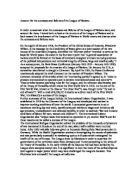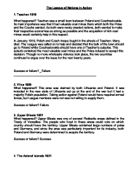The International Refugee Organization solved the problem of the thousands of prisoners of war marooned in Russia at the end of the war; about half a million were returned home. After 1933 valuable help was given to thousands fleeing from Nazi persecution in Germany. While the Health Organization worked at investigating the causes of epidemics and was particularly successful in combating typhus in Russia which endangered the health of the rest of Europe. The League drew up Mandates in order to supervise the governments of the territories taken from Germany and Turkey according to the terms of the Treaty of Versailles. In the early 1920's all the disputes that had been settled by the League were accepted except two. It is significant to note that none of the settled disputes went against a major power which may have challenged the League's decision. This illustrates how successful the League actually was.
The League of Nations was also quick to prove its value by settling the Swedish-Finnish dispute over the sovereignty of the Aaland Islands (1920–21). The League decided in favour of Finland. This was the “first European international agreement to be concluded under the … League”9. The division of Upper Silesia in 1922 was also settled by the League, Germany and Poland had disagreed over the industrial area. The League decided to partition the area between the two countries. The League’s decision “provided the basis for a peace in Eastern Europe”10. Greek troops invaded Bulgaria in 1925 after some shooting incidents on the frontier. The League swiftly intervened and prevented the outbreak of war in the Balkans, showing “how effective in such situations [the League] could be”11. Greek troops were withdrawn and damages paid to Bulgaria. Turkey claimed the province of Mosul which was part of the British mandate of Iraq. The League ruled in favour of Iraq and therefore Britain, and although it played a somewhat “subsidiary role…it served as the channel through which a settlement was reached”12. It guaranteed the security of Albania in 1921 and rescued Austria from economic disaster. Other Disputes involved Bolivia and Paraguay, Peru and Columbia, and are all issues reflecting the successful aspects of the activities of the League.
Although the idea of the League was an excellent and noble idea, it was fatally flawed from the onset by the non participation of the United States. The League could only be “as strong as those countries willing to support it”.13
Other key failures include the Disarmament Commission, whose committee made no progress in persuading the member states to reduce armaments, though all had agreed to do so when they agreed to the covenant of the League of Nations. “The failure of disarmament was a great blow to the leagues prestige”14
Both Poland and Lithuania had rival claims to Vilna. The League of Nations was over ruled by the Conference of Ambassadors in Paris which was formed to deal with problems arising out of the Versailles Treaty. During a boundary dispute between Greece and Albania, an Italian General was sent to investigate and he was shot in Greece. The reasons for the shooting were never clear, but Mussolini immediately ordered the shelling of Corfu, a Greek island and demanded heavy compensation. The League offered a solution, but the Conference of Ambassadors rejected it and rewrote one in favour of Italy upon heavy pressure from Italy and Mussolini. “The league council…could do little more than urge the allied body to bring the matter to a close”15
In 1931 Japan controlled most of the economy of Manchuria. It owned the important mines, railroads, factories and ports. It kept a large army in the port city of Kwantung to protect these assets. The world wide depression had hit Japan hard and many people within Japan saw conquering new territory as a way out of the depression. During the night of September 18, Japanese soldiers blew up a section of the Japanese railroad and blamed the explosion on the Chinese and so had an excuse to occupy the city of Shenyang. China asked for the Leagues help. The League ordered the troops to withdraw. Japan agreed to order the withdrawal of the troops, but the Japanese government did not have control over their troops. The Japanese army continued to advance into Manchuria. By the end of 1931 the Japanese troops had control of the entire province of Manchuria which they renamed Manchukuo.
The League of Nations was meant to keep the peace through 'collective security'. If persuasion did not work, the League could use economic sanctions (a ban on trade with the attacker) or military sanctions (a League army) against the attacker. Although these were options, none of the members of the League of Nations wanted to use sanctions against Japan. First, because the Depression had damaged the Worlds’ economy no nation wanted to worsen the damage. Second, the powerful members of the League, Britain and France, did not think that they could enforce the sanctions. They believed that if they tried to enforce them, Japan would seize Hong Kong and Singapore.
The solution that was reached was to set up a commission. In October of 1932 the Lytton Commission recommended that the Japanese should leave Manchuria and it should continue as a semi-independent country instead of returning to China. The League approved the Commissions recommendation, but by 1933 Japan left the League and went on to occupy the Chinese province of Jehol. The Japanese justified the invasion of this mountainous province because it was vital to the defence of Manchuria.
The Manchuria affair damaged the reputation of the League. One of its leading members had gone to war with another member and the League had failed to stop it. By the end of the affair in 1933, even the League's strongest supporters had doubts about its ability to maintain world peace.
The Italian Invasion of Abyssinia in 1935 was perhaps the most serious failure of the League of Nations. Italy wanted to expand its overseas colonies and in October 1935 invaded Abyssinia. The League condemned Italy and introduced economic sanctions which however did not include a ban on exports of coal, oil and steel to Italy. These are vital to modern warfare. So ineffectual were the sanctions that Italy was able to complete the conquest of Abyssinia by May 1936. A few weeks later sanctions were abandoned and Mussolini had disregarded the League. Britain and France had not wanted to antagonise Mussolini and had even tried to form a covert deal with him during the invasion to give him two thirds of Abyssinia. They did not want to drive him into an alliance with Hitler. Mussolini was irritated by the sanctions anyway and began to move closer to Hitler; small states lost faith in the League; and Hitler himself was convinced to break the Versailles Treaty.
After 1935, the League was not taken seriously again. Faced by threats to international peace from all sides - the Spanish civil war, Japan's resumption of war against China (1937), and finally the appeasement of Hitler at Munich (1938) - the League collapsed. The International Labour Organisation continued to function and eventually became affiliated with the United Nations, but in 1946 the League dissolved itself, its services and real estate were relocated to the United Nations.
I believe that, overall, the League of Nations was neither a complete success nor a complete failure. Predominantly, I think it can be considered a failure due to the fact that it was “only as strong as those countries willing to support it”16. But its successes such as it’s extended considerable aid to refugees; its help to suppress white slave and opium traffic; its pioneering work in surveys of health; its extended financial aid to needy states; and its broadening of international cooperation in labour relations and many other fields were so important at the time and were undeniably a starting point for the foundation of the United Nations.







